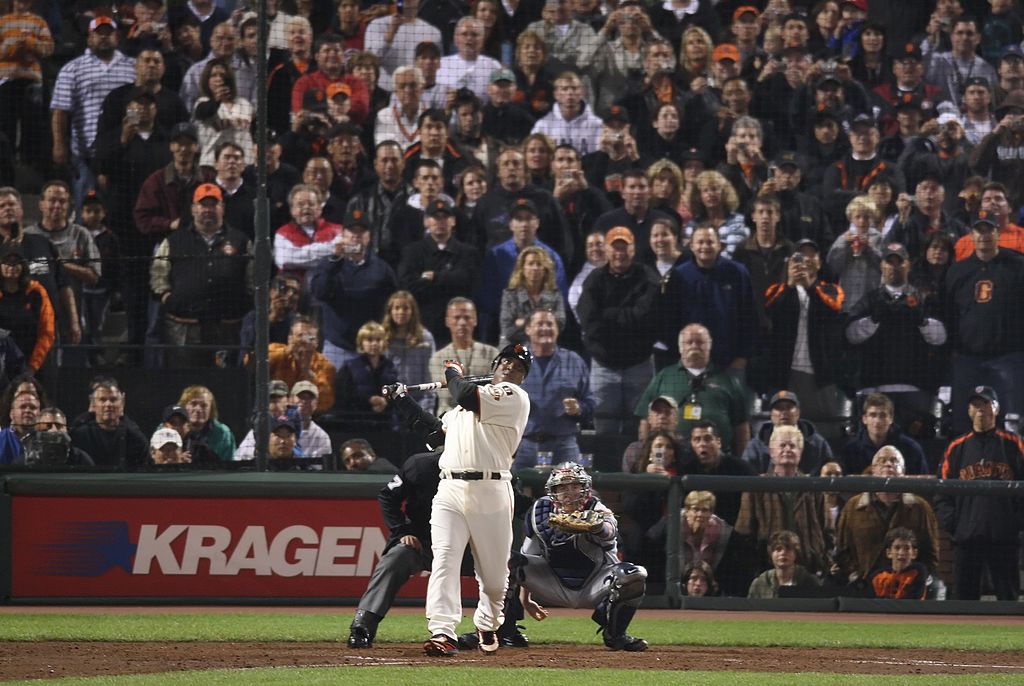Should we start with the disclaimer first? Sure, why not? We know and like Mark Fainaru-Wada and T.J. Quinn, the authors of what we hope against hope would be the last "Are Barry Bonds And Roger Clemens Hall of Famers?" story ever, and we like and respect the work of numbers-cruncher Dan Szymborski. But when ESPN editors decided to play let's-pretend with the PED era for what is essentially the last HOF roundup for both of them and assigned two of their best investigative reporters to a game of alternate universes, they wasted the collective times of all three lads (and yes, Szymborski could have just as easily spent his time breaking down Jeromy Burnitz's career) ... and yours, too.
First, though, this, which aims to project how the back half of Bonds's and Clemens's careers would have unfolded had they not taken PEDs:
Instead of hitting 73 home runs in 2001, the ZiPS projection suggests Bonds would have hit only 23 that year, plus or minus a couple. And where he actually hit 209 homers during the four seasons (2001 to 2004) he used the BALCO concoction, he was projected to hit just 66 during those four years.
According to ZiPS, where should Bonds be on the all-time home run list? Rather than the king, with 762, the projection has him at 551 career homers -- placing him at No. 15, below Manny Ramirez (well, that's another discussion) and above Mike Schmidt. It's also worth noting that the projection suggests Bonds would have played one fewer season than he did.
ESPN
We shan't dispute a single digit of Szymborski's work because, well, he invented the ZiPS player projection system employed here and if he can't use it correctly, then what is to become of Jay Jaffe? But what exactly are we doing here? Pretend numbers tend to be just as malleable as the user or users want them to be. Rather than stopping at Bonds and Clemens, Szymborski could have pissed away the last three months of his life applying the what-if-players-decomposed-today-like-Heinie Manush-once-did standard to every player to prove that, yes b'golly, PEDs helped players do more and better things. We thought we already knew that but, what the hell, everybody's gotta eat, and editors tend to know less than reporters do while telling the reporters what to do because they apparently do drugs in editorial staff meetings, too.
And let's face it, fantasy sports is clearly better than the real stuff because who doesn't like making their fantasies come true, even if it is only in the bouncy castles of their own minds?
But here's the flaw: Szymborski's numbers assume a lot about a little, and are in any event charmingly meaningless because Bonds and Clemens do exist, they did what they did, all the other players who did what they did did what they did, and in any event Major League Baseball tacitly approved of it all by cashing every single check until Senator George Mitchell got on their asses and reminded them in no uncertain terms that Washington, D.C., still didn't have a baseball team, thus convincing owners that PEDs were actually bad. Now none of the billions of dollars the owners collected from this chemical Mardi Gras were ever returned to their original owners, and the spike in the game's popularity made everybody rich without the compunction of guilt. This matters because MLB sets the rules of engagement, and by doing nothing for two-plus decades except cashing checks, it said, OK by us, kids. Needles at the ready, in three ... two ... one ...
But let's ignore that part, even though it is the most salient fact here. The fact is that, for good or ill, there were drugs in baseball, and the measuring of what actually did happen is more important than the measuring of what might have happened, particularly if PEDs were an issue across the sport rather than in just two lockers and four glutes—which it was. To quote from the lads:
Szymborski is the first to admit that his projection system is not an exact science -- maybe something akin to predicting the weather -- and that the drugs can't account entirely for the sizable differences between the projections and the players' real, larger-than-life numbers. Yes, modern-day players are in far better shape than their predecessors, working out harder and more consistently (though PEDs actually are part of that equation in some cases). Players' careers are lasting longer, as they recover faster from injuries and benefit from a more scientific approach to the game. And, of course, Bonds and Clemens faced an untold number of opponents who used PEDs, too.
ESPN
The last sentence is particularly helpful here, but the list of caveats in that paragraph essentially say, Yeah, we know some stuff but we can't ever know nearly enough to make proper sense of it. And therein lies the grandest flaw of all. Flawed science based on incomplete data isn't science at all, and it barely qualifies as useful math. This is essentially a story with a headline that reads, "Sure They Did All That, But What If They Didn't?" Without having data that goes beyond the "Jesus, look at the size of his head" eye-test for one guy, without any information on any of the other guys of the era, and indeed without information on when the era actually started, what's the reasoning here other than, "We don't like Bonds and Clemens?"
But here are the indisputable facts: Everyone did what they did, they did them a lot, and it only takes a Cooperstown area contractor and a few workmen to wall off a part of the Hall and stick everyone from 1967, when former pitcher Tom House told a reporter that he experimented with PEDs to address baseball's already evident milligram gap, in a separate room painted in filth to satisfy the puritans.
Or we can all sit down and agree that the people who operate and defend baseball should probably act like grownups and say this instead:
We did it for the money, you naive simps, just like we did the color line and five rounds of expansion and livelier and deader baseballs and seven-inning doubleheaders and arbitrary baserunners. We did it because baseball actually isn't the most rigid of sports as you might imagine, but as the most malleable. We'll do anything to anything if it means you give money to us and we get to keep it.
All this is, if it has a name, is fetishizing some arbitrarily assigned new numbers to old deeds. It's too difficult to say, "The people who ran, supervised and played baseball were committing massive felonies but were cool with all of it because everybody was getting their taste, and sports figures on both sides of the desk have a much more casual and even frosty relationship with fair play and even the law than they want to admit." Szymborski's numbers say what they say, and I would defend his math skills against anyone. They just don't say anything about what actually happened, or how many times, or for whom, or to whom, and explains nothing in an old and pedantic way.
Other than that, good read, everyone. You're all been good sports about it, and have a nice holiday while baseball eradicates drug use, and games, in 2022.






